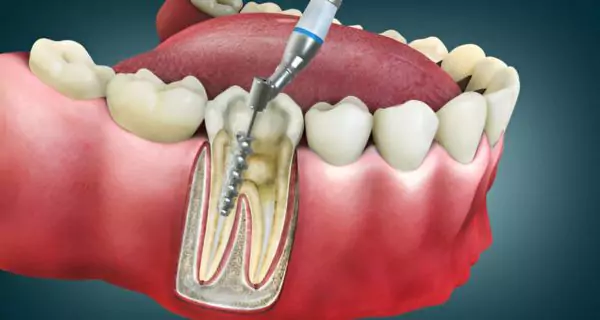Tooth pain can stop everything. It makes it hard to eat, talk, sleep, or even think.
You know how unbearable it can feel if you’ve ever had a strong toothache. That’s why when someone hears they need a root canal, it’s normal to feel anxious or even scared. It’s one of the most misunderstood treatments in dentistry. Many imagine a painful experience, hours in the dentist’s chair, and a long, uncomfortable recovery.
But the truth is very different. You don’t have to be afraid. Today, the procedure for root canal is safe, effective, and even painless. The treatment not only saves your natural tooth but also gets rid of that pain that’s been controlling your day (and night).
In this article, we’ll explain what a root canal is, why it’s needed, and what happens during treatment. That way, when it’s time for your visit, you’ll feel calm, prepared, and know exactly what to expect.
What is a root canal?
Every tooth has a soft center inside, called the pulp. The pulp contains nerves and blood vessels; and it is essential because it helps the tooth grow when you’re young, and it keeps the tooth alive, providing nutrients and sensation.
Sadly, the pulp becomes infected, inflamed, or dies, usually because of deep decay, repeated dental work, cracks, or trauma. The tooth can become very painful or swollen, and if it’s not treated in time, the infection can spread or lead to an abscess (a buildup of pus).
That’s when your dentist may recommend a root canal to stop the pain, remove the source of infection, and allow you to keep your natural tooth.
Is the procedure for root canal painful?
Thanks to modern techniques and local anesthesia, most people feel little to no pain during the procedure. You’ll be fully numb in the area being treated. At most, you might feel some pressure or movement, but no sharp pain.
How do you know if you might need a root canal?
Here are some common signs to watch for:
- strong pain when chewing or biting
- sensitivity to hot or cold that doesn’t go away after the trigger is gone
- a cracked or chipped tooth
- swelling or tenderness in the gums, especially near one tooth
- pimples or small bumps on the gums
- a tooth that looks darker or gray compared to the others
- deep decay or visible dark spots near the gum line
If you notice any of these symptoms, don’t ignore them. The sooner you see your dentist, the easier it will be to treat the problem.
What happens during a root canal? step-by-step
The idea of a root canal can sound overwhelming, but understanding how it works will make the whole experience feel much more manageable.
The procedure for root canal therapy takes about 60 to 90 minutes, but in more complex cases, like molars with several canals, it might take up to 2 hours.
Step 1: exam and X-rays
Your dentist will begin with an exam and take an X-ray to plan the treatment. This helps them see what’s happening inside the tooth, understand the shape of the root canals, and determine how far the infection has spread.
Step 2: numbing the area
You’ll receive a local anesthetic (a small injection) to fully numb the tooth and the area around it. If you’re very nervous, some clinics offer calming options like nitrous oxide (laughing gas) or oral sedatives.
Step 3: placing a rubber dam
A thin rubber sheet, called a dental dam, is placed around the tooth to keep it dry and clean during the procedure. It also protects the rest of your mouth.
Step 4: making a small opening
Your dentist will make a small hole in the top of the tooth to reach the pulp chamber and root canals. If there’s already an opening due to decay, they’ll simply clean and widen it for better access.
Step 5: removing the infected pulp
Precise instruments are used to gently remove the damaged pulp, nerves, and any infected tissue from inside the canals. If there’s an abscess (a pocket of pus), it may be drained at this stage as well.
Step 6: cleaning and disinfecting
The inside of the tooth is flushed with water and antimicrobial solutions to remove any remaining bacteria, debris, or infected tissue. The root canals are then shaped and smoothed to prepare them for filling.
Step 7: filling the canals
The cleaned canals are filled with a flexible, rubber-like material called gutta-percha. This seals the space and helps prevent reinfection.
Step 8: sealing the tooth
The opening in the tooth is closed with a temporary or permanent filling. This protects the inside of the tooth until a final restoration is done.
In some situations, your dentist might recommend two or more visits, especially if:
- The tooth has a complex root structure
- There’s active infection or pus (suppuration) coming from the canal
- Extra time is needed to make sure the inside of the tooth is properly cleaned and disinfected before sealing it
The goal is always to do the treatment thoroughly and safely, even if it takes a little longer. Taking the time to do it right helps protect your tooth and reduces the risk of future problems.
What should I expect after the procedure for root canal?
Your root canal is done, but your dental journey isn’t over just yet. Knowing what to expect in the hours, days, and months afterward will help you recover comfortably and protect your tooth for the long run.
In the short term: right after the procedure
For the first few days, it’s normal to experience some mild symptoms like:
- sensitivity when biting or touching the tooth
- soreness in the jaw from keeping your mouth open
- mild swelling or inflammation around the area
- a feeling of an uneven bite, especially if the temporary filling is slightly raised
These symptoms usually go away on their own and can be managed with over-the-counter pain medication like ibuprofen or acetaminophen. It’s rare to feel intense pain after a root canal; if you do, call your dentist.
To help with recovery:
- Stick to soft foods for the first day or two
- Brush and floss normally, but gently around the treated area
- Take medications as prescribed, if any were given
Most patients feel back to normal within a few days.
In the long term: final restoration
Depending on your case, your dentist will recommend either:
- A filling, if the tooth structure is still strong, or
- A dental crown, if much of the tooth is lost or the tooth needs extra support for chewing
If you need a crown:
- You’ll return for a second visit to take a mold of the tooth.
- A temporary crown may be placed while the permanent one is being custom-made.
- At the final visit, the tooth will be shaped slightly, and the permanent crown will be cemented in place.
Follow-up appointments and X-ray controls
Even after the tooth is sealed and restored, it’s important to monitor the healing process.
- Your dentist will usually schedule a follow-up X-ray after 6 months to make sure that bone and tissue around the root are healing well.
- It’s a good idea to check the tooth once a year as part of your routine dental exams.
- If everything looks good, no further treatment is needed. But if healing hasn’t gone as expected, your dentist may suggest further steps.
These follow-ups help confirm that the procedure for root canal was successful and that the tooth is healthy and stable.
Conclusion
Getting a root canal on time saves your natural tooth and helps you avoid bigger problems later on.
Root canals have a bad reputation, but the truth is they’re not bad at all. In fact, the procedure for root canal is one of the best ways to relieve dental pain and keep your natural smile.
With modern tools, great anesthetics, and experienced dentists, the procedure is smooth, safe, and practically pain-free. Once it’s done, you’ll be glad you didn’t put it off.
So, if your dentist tells you it’s time for a root canal, take a deep breath and relax; you’ve got this… and your tooth will thank you later.
Frequently Asked Questions (FAQ)
Only your dentist can confirm this with an exam and possibly an X-ray. Usually, if the decay or damage has reached the pulp (the soft tissue inside the tooth), a filling isn’t enough. A procedure for the root canal is needed to remove the infected tissue and prevent further problems.
References
1. AAE. (2024, May 23). Root canal explained. American Association of Endodontists. https://www.aae.org/patients/root-canal-treatment/what-is-a-root-canal/root-canal-explained/
2. Brazier, Y. (2023, June 27). What to expect from root canal treatment. https://www.medicalnewstoday.com/articles/142780
3. Cleveland Clinic Professional. (2023, November 20). Root canal. Cleveland Clinic. https://my.clevelandclinic.org/health/treatments/21759-root-canal
4. Stang, D. (2018, May 25). Root canal. Healthline. https://www.healthline.com/health/root-canal
5. WebMD Editorial Contributors. (2023, August 27). An overview of root canals. WebMD. https://www.webmd.com/oral-health/root-canals




















